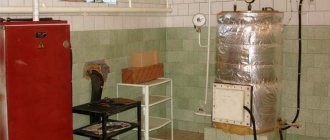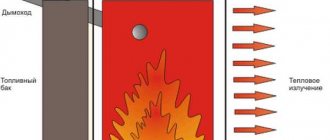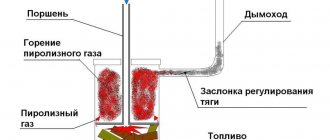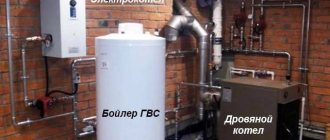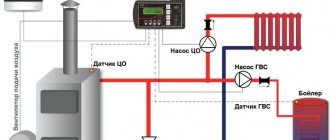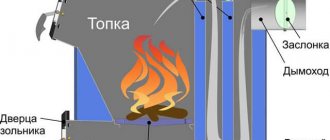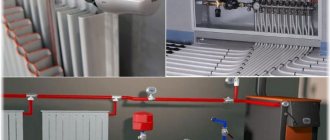Definition of the concept
There is no mental refinement in defining this type of heating boiler. Liquid fuel boilers are boilers that run on liquid fuel such as diesel fuel, also known as diesel fuel.
The main purpose of a liquid fuel boiler is to heat the house by heating the coolant of the heating circuit. Depending on the brand of the boiler, it can perform an additional function, namely, heat water in the water supply system, creating a hot water supply circuit. In general, no super tasks, just the usual tasks of all heating boilers.
Types and features of liquid fuel heating devices
The power of domestic models of boiler systems varies in the range from 6 kW to 230 kW. This condition allows you to select suitable equipment for heating small houses with an area of 50 square meters. m and spacious cottages up to 2.2 thousand square meters. m.
The power of industrial liquid fuel units ranges from 500-12,000 kW. Heavy-duty devices are capable of serving a building with an area of more than 15 thousand square meters. m.
Industrial boiler devices are divided into 2 categories:
- liquid fuel hot water boilers. The installation involves heating water under pressure,
- liquid fuel steam boilers – generate superheated or saturated steam.
Liquid fuel steam boiler
Steam generators are used in woodworking and oil production, in the furniture and food industries, in the production of animal feed and other areas. Powerful models of heat generators are in demand in block-modular boiler houses specializing in the generation of heat and steam.
Based on the design principle, liquid fuel appliances are divided into single-circuit and double-circuit models. The first ones are intended exclusively for heating the room; they are connected to radiators in which the coolant circulates through a closed heating system of the house. To ensure hot water supply, it is necessary to install a boiler, since single-circuit boilers do not heat water for domestic consumption.
The design of dual-circuit units provides an additional heat exchanger, which makes the equipment more functional. Such a device is capable of simultaneously supplying hot water to several water intake points in addition to heating the house.
Liquid fuel boilers and fuel
It so happens that when talking about household liquid fuel boilers, it is a priori understood that these boilers run on diesel fuel (diesel fuel). In fact, the burners of these boilers can also operate on other types of liquid fuel (which should be indicated in the documentation):
- Kerosene;
- Light oil;
- Various oils;
- Fuel oil.
The main requirement for fuel is the absence of moisture and the absence of abrasive impurities. It is also worth noting that each type of fuel affects the performance of the boiler and the frequency of its maintenance.
It is also important to understand that the fuel on which the boiler operates must be indicated in the documentation for the boiler and there are no omnivorous liquid fuel boilers yet.
Types of liquid fuel for boilers
In domestic conditions, in more than 80% of cases, diesel fuel (diesel fuel) is used as liquid fuel. Accordingly, it is burned by universal gas-diesel boilers or specialized diesel boiler units. In addition to wholesale purchases, you can find diesel fuel at a lower price from agricultural enterprises, tractor drivers, truck or bus drivers.
In almost all instructions for boiler units, the manufacturer indicates fuel requirements; for 2021, the standard is fuel with a viscosity of up to 6 mm2/s at 20°C. In Europe, this is a common fuel for heating private houses under the marking EL DIN 51603; in Russia, its closest analogue is the Euro-4 standard.
From the instructions for De Dietrich NeOvo EcoNox liquid fuel.
It is easiest to determine the approximate consumption of diesel fuel by a boiler, since it is known that 1 liter of Euro-4 fuel, when burned in a modern boiler with an efficiency of 90-95%, produces 1 kW of thermal energy (+-5%). As a result, the consumption of diesel fuel by the boiler = Nominal power of the boiler (kW) / 10 is the hourly consumption when operating at maximum power; in practice, the boiler is active for an average of 1/3 of the day.
For example, with a power of 24 kW, the maximum consumption is 24/10 = 2.4 l/h. In practice, this will be about 0.8 l/h - this is the most accurate generalized calculation method. Calculate the real indicator without individual initial data such as the degree of insulation of the house, temperature requirements, weather conditions, fuel quality, etc. impossible. However, it will differ slightly from the theoretical one.
Less common diesel alternatives are:
- Used oil . Much cheaper, but almost equally calorific fuel. It can be purchased for a completely symbolic price from service stations and auto repair shops, agricultural enterprises, any type of vehicle fleets, factories, and railway depots. However, the initial cost of household boilers that burn waste is extremely high (usually from 100 and even 150 thousand rubles), and due to the low environmental friendliness of the raw materials, the boilers require regular maintenance.
- Fuel oil . A more expensive analogue of mining, fuel oil of the M100 and M40 grades is most often used as fuel for heating. It is burned in heating boilers running on waste oil; it is not economically justified on a domestic scale.
- Light heating oil . Similar to diesel fuel, but since heating oil is not used in cars, requirements such as cloud point, cetane number, etc. are not observed during its production. In view of this, the price for it is on average 5% lower - 43-46 thousand rubles / ton, when diesel fuel is 45-49 thousand rubles / ton.
- Kerosene . Boilers capable of burning it are extremely rare; usually these are models that run on waste and fuel oil. It has only 5-8% higher calorific value, but costs on average 75-95 thousand rubles/t.
- Rapeseed oil . An alternative to diesel fuel, several times cheaper in cost. However, there are very few diesel boilers running on rapeseed oil, and it is extremely difficult to obtain raw materials, unless you own a rapeseed field.
Selection of fuel storage containers
Organization of the boiler room space with a plastic container for storing fuel indoors.
To store liquid fuel, even with a boiler of the lowest power, special containers are needed. They can be made of steel, stainless steel or aluminum, but today plastic is most often used - durable, lightweight and resistant to temperature changes on average from -50°C to +50°C. According to SNiP, in the boiler room it is permissible to place a container with a volume of up to 0.8 m3 (800 l), at a distance of more than 1 m from the burner. If the volume is larger, the tank must be placed behind a blank wall or outside.
When storing outdoors, it is worth considering the need for an additional pump; the characteristics of the standard pump are usually indicated in the instructions, and you should rely on them. Also, the external part of the pipeline must be insulated in accordance with the type of fuel used. For example, the viscosity of diesel fuel changes significantly at +5°C and below, and fuel oil solidifies on average at +10°C.
It is advisable to store fuel for no more than a year, and it is most profitable to stock up for the entire heating season, so for the first time you need to calculate the approximate consumption for the entire season. Further, the amount of fuel consumed will be known thanks to the practice of the past heating season.
Conclusions on consumption (calculation No. 1)
Based on the given fuel consumption data, you can estimate the cost of heating for the season.
- We take the heating season to be 6 months, or 180 days.
- For a house of 300 meters, a 30 kW boiler is required (1 kW per 10 meters).
- We choose a boiler from the list above at 34.9 kW, which consumes an average of 12 liters of diesel fuel per day. (10.0-14.5 l).
- The maximum fuel consumption for 180 days will be 180×14.5=2610 liters.
- We understand that no one will heat at maximum the whole season. We assume that for 90 days of the heating season the boiler operates at 100%, and for 90 days at 50%.
- We get: 90×14.5+90×14.5/2=1305+652.5=1957.5 liters.
- Diesel fuel 1957.5 liters costs (retail 38 rubles) 74385 rubles (1240 rubles per month).
In the article “Simplified calculation of the heating system,” I showed the calculation based on the power of the heating boiler. Below there will be another calculation that will show different results.
Advantages of liquid fuel boilers
- There are quite obvious advantages of liquid fuel boilers used in industries related to fuels and lubricants. For private homes, the advantages of boilers of this type may raise questions:
- Liquid fuel boilers have a high efficiency of 86 to 98%. This is a good indicator, and it is very close to the indicators of gas boilers;
- An undoubted advantage of diesel boilers, unlike gas boilers, is that you do not need permits (approvals) to install the boiler. Although the combustion room will still have to be equipped;
- Diesel boilers are produced in the most autonomous configurations. Automation of boilers and automatic fuel supply allow minimizing the presence of a person for maintenance;
- Another plus is the ability to quickly and easily, by changing the boiler burner, switch to working with natural gas;
- Although there are no omnivorous boilers, diesel boilers can operate on alternative types of liquid fuel, as indicated in the documentation for the boiler;
- Liquid fuel boilers can fit into any heating system and can work with any coolant (water and antifreeze).
What is the best firewood for heating?
CONIFEROS
to use coniferous wood for heating homes . Coniferous wood burns very well, but it is not recommended for heating stoves for the reasons already mentioned above. In addition, it is undesirable because such wood burns too quickly and intensely, but with minimal heat transfer. Therefore, such fuel is often purchased or prepared for heating baths, since the composition of many coniferous wood includes not only resins, but also essential oils, which are beneficial in certain quantities for human health. Thus, during bath procedures they will contribute to the prevention and treatment of the respiratory system, calming the nerves, general relaxation and relieving accumulated muscle tension.
HARDWOOD
Hardwoods are the best for heating stoves , as they have a more dense structural structure, which significantly increases their burning time with constant high energy output. Due to the absence of resinous substances in the wood, such firewood produces less soot and burning, preventing the rapid accumulation of soot in chimney pipes. Among hardwoods, there are types of wood that provide maximum heat transfer, and there are also those that will be used for ignition or for carrying out preventive measures with the stove. Stoves are also heated with fruit trees, but it is better to save this wood for smokehouses or for lighting an open fireplace, because when burned, such wood emits aromas that give the products a special taste and create a comfortable atmosphere. We need to talk about hardwood firewood in a little more detail, since they are the ones most used for heating homes.
Alder
It is interesting that alder produces the most beautiful firewood (they are also called ROYAL! ) When cut, this tree can have a yellowish, thick ocher, bluish, orange or even rich almost red color. The shades of wood depend not only on the specific type of tree (and there are about 20 ÷ 25 different subspecies of alder), but even on the place where it grew.
Alder firewood cannot be confused with any other firewood in appearance! The convenience of purchasing alder logs or ready-made firewood is that they do not need to be subjected to additional drying - they themselves reach the desired state of residual moisture. For stove firewood, alder is usually taken, which grows far from water - on hills where the soil moisture is low, which is why the wood dries out quite quickly. Alder is also good for use in smokers, as it contains aromatic substances. However, you need to know that they are stored only for the first 3 years after collecting firewood. Wood does not lose its remaining properties for a very long time and is well stored for a long period. When burning, alder produces little smoke and good heat transfer, and thanks to these qualities, such firewood was often used for “black” saunas. The evaporation of alder firewood can clean the chimney pipe of soot deposits. Alder sawdust is used for smokehouses, so they should not be thrown away if firewood is cut in the yard of the house. In addition, this wood is perfect for burning a fireplace if you put alder in it and add birch logs to it - together they give a beautiful flame and excellent heat.
Oak
Oak firewood for heating is an ideal option, but such wood is quite expensive . However, if the opportunity arose and oak firewood was purchased, you will never regret it, since they will provide excellent heat transfer, and such wood is very economical to use. It is often used as an additive to another type of firewood, since even a couple of oak logs will make the stove burn longer.
Oak firewood is very efficient heating, but it is also quite expensive! Oak has a very dense fiber structure, so its wood is much heavier than other species. It takes much longer to flare up, but it also burns for quite a long time, turning into coals, which, smoldering, keep the stove in a heated state for a long time. You should not choose too thick logs, since they are probably from a very old tree, and such wood will produce less heat. You need to take logs of medium diameter, which are sawn from middle-aged wood - this is the fuel that has the highest qualities for heating a home. Good oak firewood has a pleasant tart aroma - it is perfectly manifested when the wood burns. Therefore, such firewood is suitable not only for stoves, but also for open fireplaces. Oak essential oils create a healthy atmosphere in the room that strengthens the body and spirit. By the way, an interesting fact is that oak wood is highly valued in Italy, since it is believed that real pizza, which is considered to be the birthplace of this country, must be cooked exclusively with this wood.
Birch
Birch has been used for heating homes and baths since ancient times. Therefore, experts in natural heat even today, due to tradition, prefer to heat baths only with birch firewood. And this is not at all accidental! In addition to fragrant fumes, birch has pronounced disinfecting properties, which is important for bathhouses.
A bathhouse heated with birch firewood has always been considered healing. It is excellent for the prevention of colds and joint problems. The tar contained in birch wood helps firewood quickly take up the flame and burn with constant intensity for quite a long time. Such fuel, burning almost completely, does not produce a large amount of coal and ash. Thanks to these qualities of birch bark, it is often used as a means for igniting firewood that is heavier in structure. The heat transfer from birch logs is quite high, exceeding the heat transfer of pine and aspen by 20– 30%, depending on the age of the tree cut down for firewood. However, you also need to know that birch loses its properties after two years of storage, so it is not worth harvesting it for many years in advance. After a certain period of time, the logs begin to deteriorate from the inside, become rotten, and when burning they begin to emit an unpleasant odor. They will no longer provide the necessary heat transfer and the heat usual for fresh, dried wood.
Linden
Linden tends to flare up for a long time, but then, when the burning process begins, the intensity of the fire becomes quite high. Therefore, when burning such wood, the stove heats up extremely quickly.
Linden firewood has a good healing effect. Linden, just like birch, is also well suited for baths. It turns out that not only its color is healing - the aroma that comes along with the fumes when burning such wood also has similar qualities. For treatment in a black-heated bathhouse, honey was previously used in combination with linden firewood. It was laid out on burning logs, and the overall aromatic steam helped very well in treating pneumonia or healing various wounds on the skin. Such properties of linden firewood , alas, are preserved only for 2 years after cutting the tree, but then the healing qualities disappear. But such firewood is quite suitable for heating the stove even after this time.
Aspen
The properties of aspen firewood are very similar to the already mentioned features of alder - they are also able to soften soot deposits in the chimney, making it easier to clean. When burning, aspen does not smoke much and produces a minimal amount of soot, and its evaporation, settling on the soot present in the chimney, easily loosens and peels it off the walls of the chimney. The soot falls into the combustion chamber, from which it is very easy to remove.
Aspen is more suitable for regular chimney cleaning. Since this firewood does not provide a noteworthy heat transfer, they are often used exclusively for periodic cleaning of the chimney, or for igniting wood with a dense structure, which is difficult to ignite on its own.
Poplar and willow
Firewood from willow or poplar is used only if it is no longer possible to purchase others, or in conditions of forced cost savings, since they are much cheaper than other types of solid fuel. However, it is unlikely that you will be able to save money on them, since this firewood burns out very quickly, providing very little heat, and you need a very large amount of it to somehow heat the house.
Even the cheapness of poplar or willow will not justify the extremely low heat transfer of such firewood. It is the low quality of this wood that determines such a low price. It is worth weighing very soberly whether it makes sense to buy a large volume of low-quality firewood, or to pay the same price for more suitable types of wood, but purchasing them in slightly smaller quantities.
Firewood from fruit trees
In order to heat a house, firewood from fruit trees is perfect, but you can rarely buy it. Some of them are similar in their qualities to oak wood, for example, such as a middle-aged pear or apple tree. Since it is rare to find these varieties as firewood, they are stocked up when cutting down gardens and saved for smokehouses or for cooking meat dishes on the grill.
Disadvantages of liquid fuel boilers
When choosing a boiler, the disadvantages of liquid fuel boilers are more important.
- First of all, these are the costs of arranging a combustion room, building a chimney and installing a fuel tank with a capacity of 500-3000 liters. You can’t install such a tank in a house (although they do), which means you need space on the property. Installing a large tank is also expensive and requires adherence to technology.
- The combustion room is needed to hide the noisy operation of boilers of this type. In addition, burning diesel fuel is accompanied by oil odors.
- Environmental authorities may have big questions about tank equipment. All these are additional costs.
- Modern liquid fuel boilers are expensive, and fuel costs exceed the cost of other types of fuel.
- Another pitfall is high requirements for fuel quality. This may be a regional (local) problem.
How much fuel is needed for the season?
One of the most important questions to decide is how much fuel you will need for the season. Let's count.
Simplified, it is considered that:
- 1 liter of diesel fuel allows you to heat an area of up to 100 meters within an hour.
- The boiler consumption is calculated as the power of the burner used multiplied by 0.1.
- And as always, 1 kW of the boiler will heat 10 square meters. meters of house.
Let's make an approximate calculation, from the word example.
- Let our house be 300 meters, as in the calculation above. To heat a well-insulated house, we need a 30 kW boiler. Boiler efficiency is 93%. The burner of such a boiler will burn 32.2 kW × 0.1 = 3.2 liters of fuel per hour. This is 77.4 liters per day.
- The heating season is counted as 180 days (6 months). The maximum fuel consumption in the so-called continuous mode will be: 13932 liters (14 tons). Wow!
- We understand that the boiler will not operate at full capacity all season. For the calculation, it is assumed that the boiler will be used for half a season at 50%. Therefore, for the season for a house of 300 meters we will need:
- 90×77.4+90×38.7=6966+3483=10449 liters.
- Price: 10,449 liters×38 rubles=397,062 rubles (66,177 rubles per month). An unrealistic amount.
A logical question arises: Why, compared to the calculation using the passport (above), did this calculation above give completely different results and where is the correct calculation?
I answer: The error is 72 liters per day. Not one diesel boiler will work 24 hours a day.
As I said, diesel boilers have very serious automation. The boiler will be turned off for 2/3 days, not turned on. Therefore, the calculation should include not 24 hours of work, but 8 hours. That is, the fuel needed for the season is not 10,449 liters, but 3,483 liters.
In addition, modern boilers have technological tricks that also reduce fuel consumption, for example, multi-stage burners, burners with turbo circulation.
One more thing. The calculation given at the beginning of the article is based on the passport data of the boilers, which were compiled taking into account the quality of the fuel in the country of origin. Also, the boiler consumption indicated in the passport is slightly underestimated, since it implies ideal insulation of the house, the outside temperature is minus 10-15˚C and is given for an already heated house (heat maintenance mode).
Therefore, the correct calculation of fuel consumption for the heating season will be somewhere in the middle between 1957.5 liters according to the passport and 3483 liras according to the calculation. We remember that I considered the house to be 300 meters away.
Heat transfer of firewood
Now let’s try to figure out which firewood is better for heating and gives off the maximum amount of heat.
The specific thermal output of wood is much lower compared to hydrocarbon fuel. Let’s say that for household gas its value will be 31.8 MJ/kg, and for wood – a maximum of 17.4 MJ/kg (birch and pine). It turns out that heating the same area of a house requires, on average, a couple of times more wood. The owner will often have to visit the room in which the boiler, fireplace or stove is located. Especially during the operation of the unit in maximum combustion mode.
There are some methods for increasing the time between loadings of solid fuel:
- choose a heat generator or stove with a large combustion chamber volume;
- use firewood that gives off the maximum amount of heat.
Almost all brick stoves have a small capacity compared to solid fuel boilers, and during the heating period they require frequent addition of firewood. At the same time, the stove does not require a large amount of wood, and produces heat for a long time and with good intensity.
Burning wood in a stove
It is known that thermal output completely depends on the combustion temperature, and it varies for different wood species. A tree that gives off a lot of heat also releases more heat energy; the only problem is to use it effectively. Let’s say oak and ash give off a lot of heat; in theory, the temperature rise is 1000 °C. Poplar burns at a maximum temperature of 500 °C.
From the table below, which examines the heat output and combustion temperature of different tree species, you can figure out for yourself which wood is best to burn.
| Breed | Heat output, % (100% maximum) | Temperature, °C |
| Beech, ash | 87 | 1044 |
| Hornbeam | 85 | 1020 |
| Winter oak | 75 | 900 |
| Larch | 72 | 865 |
| Summer oak | 70 | 840 |
| Birch | 68 | 816 |
| Fir | 63 | 756 |
| Acacia | 59 | 708 |
| Linden | 55 | 660 |
| Pine | 52 | 624 |
| Aspen | 51 | 612 |
| Alder | 46 | 552 |
| Poplar | 39 | 468 |
This table shows the combustion temperature in theory, which is achieved under the best conditions. In reality, the temperature is much lower, but the ratio is similar.
Heating a stove with oak or ash is considered a luxury, since these types of wood are very valuable and are used in the production of furniture, doors and other useful things. More affordable fuel (for the northern regions and the middle zone) is birch and white acacia (for the southern regions). Less productive in this parameter together with poplar are alder firewood and willow.
Of course, every property owner uses for kindling the type of fuel that suits him and is easiest to obtain. Coniferous wood, birch and aspen are popular. In the southern territories there are poplar and acacia.
Even firewood, characterized by the highest heat output, may not please you with its heat output if it is wet.
This characteristic greatly affects the heat transfer of the floor; see for yourself by looking at the table.
| Properties of firewood at different humidity levels | ||||||
| Wood type | Pine | Birch | Spruce | Aspen | Alder | Ash |
| Calorific value of freshly cut wood (average humidity – 50%), kW/m³ | 1900 | 2371 | 1667 | 1835 | 1972 | 2550 |
| Calorific value of semi-dry firewood (average humidity 30%), kW/m³ | 2071 | 2579 | 1817 | 1995 | 2148 | 2774 |
| Calorific value of wood stored under a canopy for at least 1 year (average humidity 20%), kW/m³ | 2166 | 2716 | 1902 | 2117 | 2244 | 2907 |
You should not expect much heat transfer from wood with a high moisture content, since most of the heat is immediately lost to the evaporation of water. Therefore, it is recommended to dry freshly cut wood. Only in this case will you be able to obtain the maximum amount of heat and achieve rational fuel consumption.
How does an oil-fuel boiler work?
The operation of diesel fuel boilers is similar to the operation of a gas boiler. The leading role is played by a burner with a fan. She sprays fuel. In the combustion chamber, the fuel mixes with oxygen (air) and ignites. The combustion of the fuel mixture heats up the heat exchanger with the coolant.
In a double-circuit boiler, there is a second circuit through which water flows from the water supply system, creating a hot water supply system.
Speaking about the similarities in the operation of gas and diesel boilers, it is worth remembering that most liquid fuel boilers can be quickly converted to operate on gas (and vice versa). Only the boiler burner is replaced and that’s it.
For example, the De DietrichGT123 boiler runs on liquid fuel or gas. When purchased, it works with a pressurized liquid fuel burner, which can be replaced with a gas burner to operate on gas. The diagram shows a similar Kiturami double-circuit boiler.
Types of diesel boilers
So, due to the impossibility of using other common energy sources, you have decided to install liquid fuel heating in your home. The time has come to choose a heating boiler, and here you should figure out what types of these products exist and choose the most suitable option. Manufacturers offer liquid fuel heating boilers of the following types:
- diesel boilers;
- universal units, they provide the possibility of switching from diesel to natural gas;
- diesel fuel condensing boilers;
- installations that burn all types of waste oils.
If the situation with energy resources is not expected to change in the foreseeable future, then your option is to heat a private house with a heating boiler of the first type, which burns only diesel fuel.
For reference. Most of these installations can also operate on liquid biological fuel, which is obtained from industrial crops (biodiesel). This option can be very useful if such an energy source is available to you.
Some homeowners who are looking for a heating boiler believe that they can also burn waste from their car in a diesel boiler. This is the wrong approach, and for the following reasons:
- Not every burner device operates on contaminated oils.
- The calorific value of liquid fuel is much higher than that of waste oils. Accordingly, the areas of heat transfer surfaces are calculated for liquid fuel; during combustion, the efficiency will be significantly lower.
- During combustion, the exhaust emits significantly more soot, which settles throughout the entire smoke duct. This can be a big problem when maintaining and cleaning smoke pipes.
In their design, liquid fuel boilers are very similar to heat generators running on natural gas. Accordingly, many manufacturers offer universal water heating units with alternate use of liquid and gaseous fuels. The transition from one type of fuel to another is carried out by replacing the burner device. True, a universal boiler that runs on liquid fuel and main gas will cost you a little more.
If the area of the heated room or building is less than 200 m2, and in the near future you expect connection to a gas pipeline, then you should not rush to purchase a universal heater.
The fact is that the cost of a boiler block and two burners may be higher than two separate full-fledged units. Therefore, first you can install a diesel boiler, and after connecting to the main line, buy and install a gas heat generator. You can find out more information by watching the video:
Condensing domestic diesel boilers are the most economical and efficient representatives of this family of heat sources. Manufacturers declare the efficiency of their condensing units at 97%, this is the highest figure among all other heaters. As usual, their cost is quite high and not every owner can afford to include such a high-tech product in their heating system.
It is very good if you have access to such a secondary resource as used automobile oil in sufficient quantity. Then there is a waste oil boiler specifically for this purpose, the product is manufactured and offered on the market by many manufacturers. Also, similar heating boilers have been well mastered by various craftsmen who make homemade heaters.
Oil burner
For liquid fuel heating units, fan (pressurized) burners are used. They atomize liquid fuel entering the burner under pressure with the required atomization ratio. Air is also forced into the burner, which is correctly called forced air.
The fuel mixture is ignited by electrodes. Further operation of the boiler is ensured by built-in automation.
Here it’s time to note that the design of boilers contains a lot of electronics and equipment powered by electricity (fans, pumps). This makes diesel boilers electrically dependent and this must be taken into account when purchasing and installing. If your home has frequent electrical problems, then you need to take care of a backup power supply.
Types and operating modes of burners for liquid fuels
Some manufacturers sell liquid fuel heating boilers without burners. And that's why. The choice of burners for liquid fuel is quite large and there are many differences in types and operating modes.
Burner types
There are the following types of burners based on fuel:
- Mono fuel burners. They run on only one type of liquid fuel, usually diesel fuel. To switch to oils, you will have to change the burner nozzles.
- Bi fuel burners. They operate on several, often two, types of fuel. There are combinations: diesel-gas, diesel-wood, diesel-wood-coal, etc.
Types of burners by operating mode
We also pay attention to this:
Single-stage burner. Quite primitive, but because of this it is a reliable burner. Adjustment is made by simply turning the burner on/off. They are distinguished by maximum power output and maximum fuel consumption.
Multi-stage burner. This burner is configured to operate according to complex smooth on/off algorithms through intermediate power values. Such burners are expensive, but they save excellent diesel fuel. Typically, such burners are installed on powerful boilers from 40 kW.
Characteristics of firewood
Wood of each species has its own individual characteristics, sometimes very different from each other. Therefore, some types of wood are more suitable for construction, while others are more suitable for heating homes. Not all firewood is equally good for heating purposes. In addition, you need to take into account that, by and large, almost all firewood is suitable for the stove (of course, not to the same extent, but still), but for the fireplace you need to choose fuel that will bring into the room, in addition to warmth, also a pleasant aroma will create a favorable, cozy atmosphere. Thus, fuel made from too resinous rocks is not suitable for a fireplace, since such wood creates excessive smoke and soot when burned. Moreover, for example, when pine firewood burns, it very often shoots out embers that can land on flammable surfaces, and then the probability of fire is very high. That is why coniferous species are not recommended for use in open fireplaces. For the stove, it is optimal to choose firewood that burns for a long time, with low intensity and pronounced heat transfer. An important factor for firing a stove is the minimum amount of smoke emitted by burning wood, as well as ash remaining in the firebox. Good firewood, most suitable for heating a stove, should be well prepared for the winter period - dried and folded for storage. All of the above qualities directly depend on the quality of these events. Undried, freshly sawn wood is never used immediately for heating, since it dries out in the firebox, produces a lot of smoke, and then burns very sluggishly due to the large amount of moisture. The combustion of such fuel produces very little heat, and that is why “fresh” wood must be thoroughly dried. You can check how dry the firewood is in the old simple way: if when one log hits another, a ringing sound is heard rather than a dull sound, then the wood is fully ready to go into the stove. High-quality firewood can be obtained from trees that are cut down in winter - during this period there is practically no movement of sap in the tree trunks. But trees cut down in summer or spring require longer drying, since they have a very high percentage of moisture.
Fuel storage tank
Now comes the fun part. An oil-fuel boiler requires a container for storing fuel, and I listed this as a disadvantage a little higher.
The calculations shown above indicate that a capacity of several tons is needed. There is no need to invent anything here and it is better to buy a ready-made container with all the built-in equipment: a float, a vapor outlet, a drain valve, a fuel intake kit, a pipeline for discharging fuel to the burner, etc.
Material for containers is steel, polyethylene, fiberglass.
To install the tank, site preparation, excavation, concreting and a lot of special work will be required. You need to understand this and most likely, you will have to hire specialists.
Automation (control)
According to its characteristics, fuel can be supplied to the boiler independently; it does not need to be thrown in like firewood. Therefore, in boilers of this type, maximum attention is paid to automatic control, which minimizes the presence of a person in the operation of the boiler.
Using the example of the Kiturami boilers I came across, let’s see what is included in the boiler automation. On the body we see sensors for fuel level, temperature, and overheating. Yes, electronic remote control unit. Boiler indicators allow you to monitor the temperature of the coolant in the heat exchanger, circulation pump, burner, and power supply. Tricky buttons “Sleep”, “Shower”, also elements of universal automation. That's a plus.

